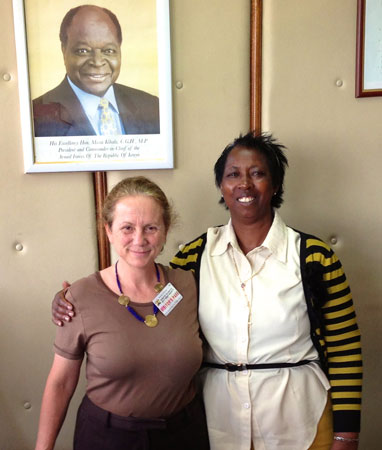The Health Policy Project ended in 2016. Work continued under Health Policy Plus (HP+) until 2022.
NEWS & VIEWS
“What Works for Women” Website Used to Inform New National Gender Policy in Kenya’s Health Sector
Posted March 8, 2013
|
|
Dr. Maryanne Ndonga, head of the Department of Gender, Human Rights and Education under the Ministry of Medical Services in Kenya (right), and Jill Gay (left), lead author of What Works for Women and Girls: Evidence for HIV/AIDS Interventions website. Dr. Ndonga learned about the website at a USAID-funded Health Policy Project seminar. She is using the website to help develop the country’s national gender policy in the health sector, as well as to inform the national HIV strategic plan. Photo by Health Policy Project. |
Dr. Maryanne Ndonga knew she had a unique opportunity to help women and girls in Kenya. As the head of the Department of Gender, Human Rights and Education under the Ministry of Medical Services, she is responsible for developing a new gender policy for the nation’s health sector. In the policy, Dr. Ndonga seeks to protect women and girls from a growing vulnerability to HIV.
Gender norms in Kenya encourage men to engage in multiple risky partnerships, and translate into power imbalances that make it difficult for women to negotiate safe sex. In 2012, an estimated 1.6 million people in Kenya were living with HIV, where 44% of new infections occurred through heterosexual transmission among married couples or primary partners.
In a country where young girls are four times as likely to acquire HIV compared to males, Dr. Ndonga believed that Kenya needed to increase its focus on reaching females with services to help them prevent HIV. She also recognized a need to make HIV care and treatment part of basic healthcare services -- a shift in approaching HIV as a chronic illness and providing persons living with HIV with better access to life-saving antiretroviral therapy and other services to keep them healthy. This would require the commitment of government leaders and policymakers, who need reliable data and information to help them plan health and HIV programs.
To create this evidence base, Dr. Ndonga had to assess what interventions were working to protect women from HIV in Kenya. She also needed information on which approaches have been most effective in reaching women and girls with HIV services in other countries, and determine whether they could be replicated in Kenya.
In August 2012, Dr. Ndonga learned about a valuable resource at a USAID-funded Health Policy Project seminar – a website called What Works for Women and Girls: Evidence for HIV/AIDS Interventions. The site provides information about women’s health in developing countries, featuring materials based on a comprehensive review of evidence from more than 2,000 articles and reports on programs conducted in more than 90 countries. Users can also share information on successful interventions in HIV prevention, treatment, care, and support, as well as policies and programs that address violence and gender norms.
While most research is written for other researchers, What Works translates the research into useful information for people such as Dr. Ndonga, who are working on the frontlines. The website also documents effective interventions in simple, straightforward language suited for busy policymakers.
Dr. Ndonga found many effective interventions that could be adapted and applied in Kenya, from scaling up the promotion and availability of female condoms to educating men and women about gender equity to reduce violence and prevent the spread of HIV.
During a follow-up meeting with Health Policy Project consultant Jill Gay this past February, Dr. Ndonga shared that she was also working with Kenya’s National AIDS Control Council to address gender equality in the new national HIV strategic plan. “We are using information from What Works for Women and Girls: Evidence for HIV/AIDS Interventions to incorporate into our national Kenyan policy,” says Dr. Ndonga.
Dr. Ndonga is confident the new evidence-based policy will be more robust by addressing key challenges that gender norms and inequalities pose to females, giving women and girls throughout Kenya a better chance to be healthy and free of HIV.
About What Works for Women and Girls
What Works for Women and Girls is supported by the U.S. President’s Emergency Plan for AIDS Relief (PEPFAR) and the Open Society Foundations and is being carried out under the auspices of the Health Policy Project and the Public Health Institute. For more information, please visit www.whatworksforwomen.org.
What's New
- Something to Build On: “Innovation Exchange” Celebrates the Health Policy Project’s Close and a New Beginning
- What Will it Take for Tanzania to Achieve ART Targets and Ensure Long-Term Sustainability of the HIV Response?
- Helping Kenya’s County Leaders Advocate for Increased Health Investments
- HPP Holds Working Meeting on Ensuring Responsible PEPFAR Transitions for Key Populations
- Health Policy Project Celebrates 2016 International Women's Day
- HPP Staff Participate in White House Conference on HIV Stigma Reduction


